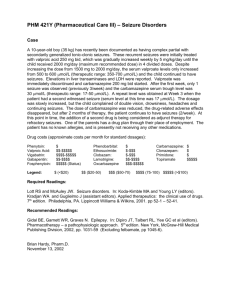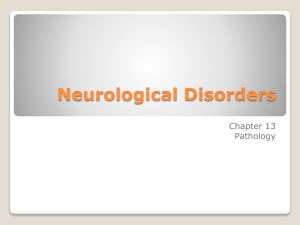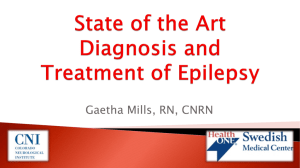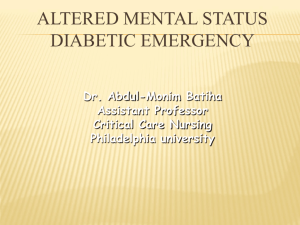Neurologic System
advertisement
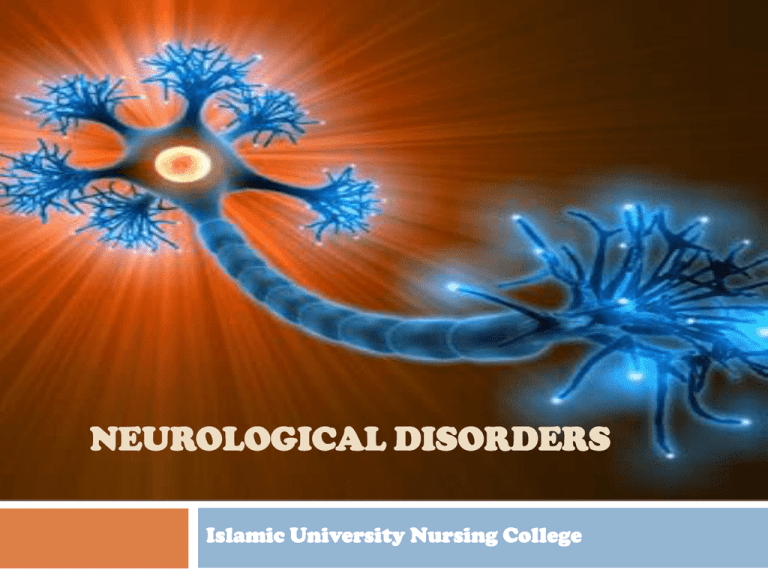
NEUROLOGICAL DISORDERS Islamic University Nursing College Neurologic System Neurologic System Nervous system consists of Brain Spinal cord Cranial and spinal nerves Cerebrospinal fluid The Central Nervous System (brain & spinal cord) The Peripheral Nervous System The Autonomic Nervous System Sensory-somatic Nervous System Neurologic System The brain is covered by three membranes. The dura mater is a fibrousconnective tissue structure containing several blood vessels. The arachnoid membrane is a delicate serous membrane The pia mater is a vascular membrane The Peripheral Nervous System is composed of the cranial nerves and the spinal nerves Neurologic System The spinal cord extends from the medulla oblongata to the lower border of the first lumber vertebrae. It contains millions of nerve fibers, and it consists of cervical, thoracic, lumber, and sacral nerves Cerebrospinal fluid (CSF) forms in the lateral ventricles in the choroids plexus of the pia mater. it circulates to the subarachnoid space of the spinal cord, bathing both the brain and the spinal cord. Neurologic System : function Consciousness, thought, emotions, memory, sensory input and motor activity Regulates BP, Temp, breathing, digestion, cardiovascular function..etc Coordination of muscle movements Neurologic System :Cardinal signs & symptoms Headache, fainting and dizziness abnormal gait, movements, or coordination developmental lags or loss of milestones Symptoms of increased ICP Increased HC Bulging fontanels Headache for older children Confusion and altered mental status; A change in the child’s normal behavior pattern may be an important early sign Tachypnea (late sign): Cheyne-Stokes respiration. This pattern of breathing is characterized by increasing rate and depth, then decreasing rate and depth, with a pause of variable length altered level of consciousness (LOC) Neurologic System :Cardinal signs & symptoms Altered level of consciousness (LOC) Disoriented; lack of ability to recognize place or person. Obtunded ; individual who sleeps unless aroused and once aroused has limited interaction with the environment. lethargy; when a child awakens easily but exhibits limited responsiveness. Stupor; requiring considerable stimulation to arouse the individual. Neurologic System : Assessment Prenatal, personal and family history Prenatal: maternal malnutrition, drug use, alcohol use, and illness prematurity, perinatal hypoxia, birth trauma, delayed developmental milestones, head injury, meningitis, chronic illness, child abuse, chromosomal anomalies and substance abuse. Family: chromosomal anomalies, mental illness, neurologic disease, seizure disorders, mental retardation, learning problems, and neural tube defects Neurologic System : Physical Exam HC: (head circumference in children younger than 2 years) Assess LOC, general appearance, behaviour, interactions, speech, behavioural changes Assess development milestone Assess cranial nerve function Assess taste, olfaction, and tactile sense Observe abnormal movements such as tremors, seizure activity Neurologic System : Physical Exam Assess gait, balance, coordination & Assess reflexes Palpate the fontanels with infant upright position Assess muscle tone and strength Assess sensation and position sense Assess deep tendon and superficial reflexes Neurologic System :Lumber puncture Position: The child should lie on her side with knees bent and chin tucked in to the knees. This position exposes the area of the back for the lumbar puncture Meningitis Meningitis is inflammation of protective membranes that covering brain and spinal cord (meninges). Meningitis may extends to the ventricles and the exudation (fibrin) obstruct the flow of CSF Caused by: Virus Bacteria Other microorganism Drugs Bacterial Meningitis The most common are group B streptococci during the 1st 2 mo of life H. influenzae (type B) Meningococcal; occurs most often in the 1st year of life tends to occur in epidemics among closed populations Streptococcus pneumoniae (pneumococci); the most common cause of meningitis in adults people at risk: chronic otitis, sinusitis, mastoiditis, CSF leaks Bacterial Meningitis Bacteria typically reach the meninges by: hematogenous spread from sites of colonization in the nasopharynx or other site such as lungs Bacteria can also enter CSF by direct extension from nearby infections (e.g, sinusitis, mastoiditis) through exterior openings in normally closed CSF pathways such as Meningomyelocele penetrating injuries neurosurgical procedures Ventricular shunt Bacterial Meningitis: Infant Abrupt & nonspecific signs Extremely irritable Lethargic difficult to comfort ; a high-pitched cry jaundice (a yellowish tint to the skin) stiffness of the body and neck(Nuchal rigidity) fever or lower-than-normal temperature poor feeding/ a weak suck/ vomiting bulging fontanelles / Seizures Bacterial Meningitis: Clinical Manifestation pre-infection; respiratory illness/sore throat Fever, headache, stiff neck, vomiting Kernig’s & Brudzinski’s Seizures Cranial nerves abnormalities Changes in consciousness, irritability … coma Purpura/petechia (meningococcal meningitis) Bacterial Meningitis Bacterial Meningitis: diagnosis & Treatment The primary diagnostic test for meningitis is lumber puncture (LP) Pressure & color Glucose WBC protein Normal 100-200mmH2O 50-100 mg/dL 0-5 20-45 mg/dL Bacterial Meningitis >300 Cloudy/milky < 40 Elevated > 100 Viral/aseptic N or increased N N or mild N or < 100 elevated Treatment Antibiotics (Ampicillin/vancomycin) corticosteroids Supportive care Isolation Bacterial Meningitis: Nursing diagnosis Potential for injury: secondary brain injury R/T increase intracranial pressure or disease process Altered comfort: pain R/T headache, muscular rigidity and I.V therapy Fear/ anxiety child and the family R/T diagnosis of series disease. Bacterial Meningitis: Nursing Care Isolation (contact isolation ) Monitor V/S and neuro assessment Provide quiet environment Control fever and pain Prevent complications of increased ICP and dehydration Viral Meningitis Common in children younger than 4 years Mostly caused by entero viruses Associated with mumps or herpes CM Gradual signs of headache, fever, malaise, vomiting Meningeal irritation (signs) develop 1-2 days after the onset of illness Treatment Symptomatic (rest, fluids, antipyretic, analgesics) Isolation is not necessary Signs and symptoms subside within 3-10 days with no residual effects (complications) Encephalitis Acute inflammatory disease of the brain Usually viral; Herpes Simplex: most common sporadic type Acute febrile illness with symptoms of meningitis AND neurologic signs such as aphasia, seizures, cranial nerve involvement Patient may present with fever, facial paralysis, headache, seizures, nausea and vomiting CT scan usually initially normal; MRI more helpful Death occurs in 70-80% of patients if treatment not begun before patient becomes comatose Spina Bifida Vertebral column fails to close during intrauterine development with no definitive cause identified There are three forms: Spinal bifida occulta Meningocele Myelomeningocele Spina Bifida Spinal bifida occulta Failure of vertebral arch to close, a dimple occurs on the sacral area, may be covered by a tuft of hair. Spina Bifida Meningocele Protrusion of the meninges. Meninges consist of: dura mater, arachnoid, and pia mater covered by thin membrane No paralysis because spinal cord is not involved. Spina Bifida Myelomeningocele Protrusion of the meninges and spinal cord. Covered by thin membrane Extent of paralysis depends on the location of the defect. Results in hydrocephalus. Spina Bifida Spina Bifida: Prevention & Management Encourage folic acid 4mg Po with future pregnancies (conception-6 weeks) Primary intervention after birth of infant with meningocele & myelomeningocele is to cover defect with a sterile, saline-soaked dressing to prevent cracking in the sac thus decrease infection Prone position keeps pressure off the exposed sac Head circumference measurement is essential because hydrocephalus can develop in these infants. Surgery Primary reason of surgical repair is to prevent infection Correct defect Minimize complications such as hydrocephalus Spina Bifida: Prevention & Management Encourage parents to become involved with infant care ASAP Teach parents the techniques of feeding, ROM exercises, positioning, catheterization, skin care Explain to the parents about possible complications Spina Bifida: Nursing Diagnosis Risk for infection R/T presence of infective organisms, non-epitheliazed meringue sac Potential for trauma R/T delicate spinal lesion Potential for complications R/T impaired circulation of CSF or neuro-muscular impairment Hydrocephalus Impaired circulating and reabsorption of CSF It can be congenital or acquired It can be communicating or noncommunicating (obstructive hydro) One of the most causes of hydr0 is aqueductal stenosis Other causes include meningitis, tumors, lesions/ malformation Hydrocephalus Hydrocephalus: Clinical Manifestation Enlarged head (earliest sign) & Bulging fontenells Poor feeding & Vomiting Irritability Lethargy Dilated & distended scalp vein and setting sun eyes Positive Babinski’s reflex (fanning of toes) In older children Headache Changes in personality Cognitive deterioration Hydrocephalus: Treatment & complications Treatment V_P shunt placement Diuresis Complication Infection Visual problems Memory problems and reduced IQ Phenylketonuria (PKU) Is inability of the body to utilize Phenylalanine (amino acid) due to deficit in Phenylalanine hydroxylase enzyme It is an autosomal recessive inherited disease Normal phenylalanine in the blood is 1-2 mg/dI in PKU it ranges from 6-80 mg/dI Phenylketonuria (PKU) Infant’s symptoms of untreated PKU Microcephaly, prominent cheek and poor development of teeth Vomiting Irritability & hyperactivity Eczema-like rash Musty odor of the urine Increased muscle tone Poor body growth (failure to thrive) Fair skin Later signs of seizure and mental retardation Phenylketonuria (PKU): treatment The goal of treatment is to: prevent mental retardation by maintaining normal level of phenylalanine (< 10 mg/dl) Provide nutrition for optimum growth When the level of phenylalanine is more than 10 mg/dI brain damage occurs Screening for PKU is a routine test which is usually done at 3 days of age Phenylketonuria (PKU): treatment Treatment is dietary management (lower amount of phenylalaine) Food such as meat, fish, poultry ,eggs, cheese, milk, dried beans and peas should be avoided or taken in low amount. Cereals, starches, fruits , vegetables and milk substitute is recommended If treatment started before 3 months of age this can limited brain damage Seizure Disorders Seizure is an abnormal unregulated excessive electrical discharge (firing) that interrupts normal brain function This electrical firing may last from a few seconds to minutes 50% of seizures the causes are unknown Seizures before 2 yrs usually caused by developmental defects, birth injuries or metabolic disorders Seizure could partial (affect part of the brain) or generalized Seizure may be due to disorder such as epilepsy OR to reversible stressors such as: Hypoxia; Hypoglycemia; Fever in children, hypcalcemia, hyponatremia Seizure Disorders Seizure usually lasts from few seconds to 1-2 minutes Seizure usually causes Alteration in awareness, sensation & emotion Involuntary movements Convulsion Mostly seizure followed by deep sleep, headache, confusion, paralysis ( postictal) Postictal may lasts from minutes to hours Seizure Disorders Seizure disorders are symptoms to underlying cause such as brain tumor, stroke or could be idiopathic Types are: Generalized Absence (petit mal) Tonic-clonic (grand mal) Atonic Myoclonic Infantile spasm Partial seizures Simple partial seizures Complex partial seizure Secondarily generalized partial seizures Seizure Disorders: partial seizures Simple partial seizure No complete loss of consciousness May affect the face or a hand first May developed to be generalized seizure Complex partial seizure Starts with aura Purposeless movements & unintelligible sounds Consciousness is impaired Secondary generalized partial seizure Either simple or complex partial seizure may develop into a tonic-clonic seizure Seizure Disorders: generalized seizures Abnormal motor function & loss of consciousness Types are; Tonic-clonic (grand mal) Tonic phase; cry, falling down and stiffness . Followed by clonic ( jerk rapidly and rhythmically, bending and relaxing at the elbows, hips, and knee) contractions of the muscles Frothing at the mouth, urinary and fecal incontinence may occur Seizure Disorders: generalized seizures Absence (petit mal) Mostly for children between 6-12 years Lasts for a few seconds Abrupt & brief lapse of consciousness (staring into space or absence spells), blank expression, twitching of mouth, blank stare ,daydreams May occur many times a day Atonic seizure Complete loss of muscle tone and consciousness Risk for head injury Seizure Disorders: generalized seizures Myoclonic (contraction and relaxation) Jerk y repetitive movement of a limb/trunk Consciousness is not lost May followed by tonic-clonic seizure Infantile spasm Sudden flexion of the arms and trunk and extension of the legs Occurs during the first 5 yrs Status Epileptics Tonic-clonic Seizure that is lasting 5-10 minute Epilepsy is 2 or more seizures episodes that are not related to reversible stressors Longer epileptics seizures may cause permanent brain damage (more than 60 minutes. Lorazepam (Ativan) or diazepam (Valium) is given intravenously to control generalized tonic-clonic status epilepticus and may also be used for seizures lasting more than 5 minutes. Seizure Disorders: Epilepsy Assessment History Duration, frequency, sequential evolution longest and shortest interval between seizures aura, postictal state precipitating factors Risk factors; CNS infection, drug use withdrawal, head trauma, neurologic disorders Physical exam: usually normal between the seizure CBC, serum glucose, creatinine, electrolytes, CT and MRI, LP, video and EEG monitoring Seizure Disorders: Epilepsy Treatment by anticonvulsant drugs Well controlled seizures the drugs can eventually stop and the child remain seizure free (60%) Drugs such as amphetamines can trigger seizures thus should be avoided Alcohol and some drugs as phenothiazines lower the threshold of seizure thus should be avoided Avoid activity that the loss of consciousness can be life threatening such as driving, swimming and climbing or leaving a child in a bathtub Seizure Disorders: Epilepsy Drugs to control seizures Parents should be advised not to stop the anticonvulsant suddenly or without consulting the physician. Such action could result in seizure activity Parents should be advised about the side effect of Valporic acid (Depakene) such as Thrombocytopenia that causes bruising and bleeding Phenytoin (Dilantin); gingival hyperplasia. Good oral hygiene will minimize this adverse effect. Hepatic dysfunction thus serum therapeutic level of phenytoin should be carefully monitored Seizure Disorders: Epilepsy Nursing care during a tonic-clonic seizure Stay with the child until the seizure subsides Patent airway: suction and O2 supply Prevent injury by removing sharp objects DO not put any objects in the child’s mouth Loosening clothing around the neck Roll the child to the side to prevent aspiration V/S (temperature) and neurologic Administer diazepam (may cause apnea) Seizure Disorders: Epilepsy Nursing care after tonic cloinc seizure The child may be lethargic and confused If patient is febrile sponge bath Check blood glucose level Seizure Disorders: febrile seizure Benign seizure Occurs between 6 months and 6 years Is a convulsive event lasts 1-5 minutes due to rapid rise in body temperature (fever) Usually consists of jerking of extremities, eye rolling, unresponsiveness and sometimes cyanosis Sometimes it can be non-convulsive such as loss of tone and consciousness or stiffness of the body No brain damage and treatment is unnecessary Pertussis immunization 54 It is wise to avoid Pertussis immunization for infants who had neurological problems in the neonatal period, until it is clear that they do not have progressive neurological disorders.





